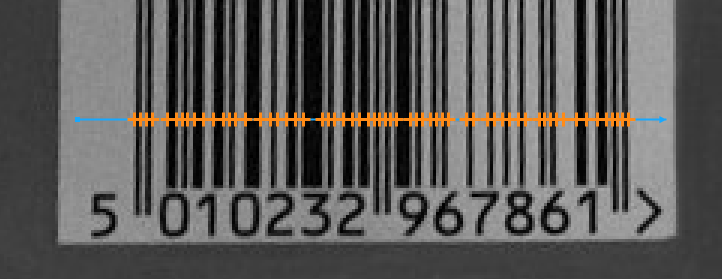You are here: Start » Function Reference » Computer Vision » 1D Edge Detection » ScanExactlyNEdges
ScanExactlyNEdges
| Header: | AVL.h |
|---|---|
| Namespace: | avl |
| Module: | MetrologyBasic |
Locates a specified number of the strongest transitions between dark and bright pixels along a given path.
Applications: Very fast object detection (or presence verification) when the expected number of edges is clearly defined.
Syntax
void avl::ScanExactlyNEdges ( const avl::Image& inImage, const ScanMap& inScanMap, const EdgeScanParams& inEdgeScanParams, int inEdgeCount, avl::Selection::Type inEdgeSelection, float inMinDistance, atl::Optional<float> inMaxDistance, atl::Optional<const avl::LocalBlindness&> inLocalBlindness, atl::Conditional<atl::Array<avl::Edge1D> >& outEdges, atl::Conditional<atl::Array<avl::Gap1D> >& outGaps, avl::Profile& diagBrightnessProfile, avl::Profile& diagResponseProfile )
Parameters
| Name | Type | Range | Default | Description | |
|---|---|---|---|---|---|
 |
inImage | const Image& | Input image | ||
 |
inScanMap | const ScanMap& | Data precomputed with CreateScanMap | ||
 |
inEdgeScanParams | const EdgeScanParams& | EdgeScanParams ( ProfileInterpolation: Quadratic4 SmoothingStdDev: 0.6f MinMagnitude: 5.0f EdgeTransition: BrightToDark ) | Parameters controlling the edge extraction process | |
 |
inEdgeCount | int | 0 -  |
1 | Number of edges to be found |
 |
inEdgeSelection | Selection::Type | Selection::Best | Selection mode of the resulting edges | |
 |
inMinDistance | float | 0.0 -  |
0.0f | Minimal distance between consecutive edges |
 |
inMaxDistance | Optional<float> | 0.0 -  |
NIL | Maximal distance between consecutive edges |
 |
inLocalBlindness | Optional<const LocalBlindness&> | NIL | Defines conditions in which weaker edges can be detected in the vicinity of stronger edges | |
 |
outEdges | Conditional<Array<Edge1D> >& | Found edges | ||
 |
outGaps | Conditional<Array<Gap1D> >& | Gaps between consecutive edges | ||
 |
diagBrightnessProfile | Profile& | Extracted image profile | ||
 |
diagResponseProfile | Profile& | Profile of the edge (derivative) operator response |
Description
The operation scans the image using inScanMap previously generated from a scan path and finds a set of inEdgeCount image edges perpendicular to the path. If no subset (of inEdgeCount elements) of detected edges meets the requirements of inEdgeScanParams.minMagnitude, inMinDistance, inEdgeScanParams.edgeTransition then the outputs are set to NIL.
Note that in case of a scan path which is closed, the parameters controlling the distances between consecutive found objects do not control the distance between the first and the last of the found objects (counting from the beginning of the scan path).
Hints
- Set inEdgeCount to the number of edges that are to be found (the N number).
- Define inEdgeScanParams.EdgeTransition to detect a particular edge type, and only that type.
- If the expected number of edges cannot be found, try decreasing inEdgeScanParams.MinMagnitude. Verify this with the values on the diagResponseProfile output.
- If consecutive edges are closer than 6 pixels apart, change inEdgeScanParams.ProfileInterpolation to Quadratic3.
- Adjust inMinDistance (in pixels) to filter out false edges that appear in proximity to other edges.
Examples

ScanExactlyNEdges locates the edges using a scan map representing the scan path above (inEdgeCount = 61).
Remarks
Read more about Local Coordinate Systems in Machine Vision Guide: Local Coordinate Systems.
This filter is a part of the 1D Edge Detection toolset. For a comprehensive introduction to this technique please refer to 1D Edge Detection and 1D Edge Detection - Subpixel Precision chapters of our Machine Vision Guide.
See Also
- CreateScanMap – Precomputes a data object that is required for fast 1D edge detection.
- ScanSingleEdge – Locates the strongest transition between dark and bright pixels along a given path.
- ScanMultipleEdges – Locates multiple transitions between dark and bright pixels along a given path.
- ScanExactlyNEdges_Direct – Locates a specified number of the strongest transitions between dark and bright pixels along a given path (without a scan map).

